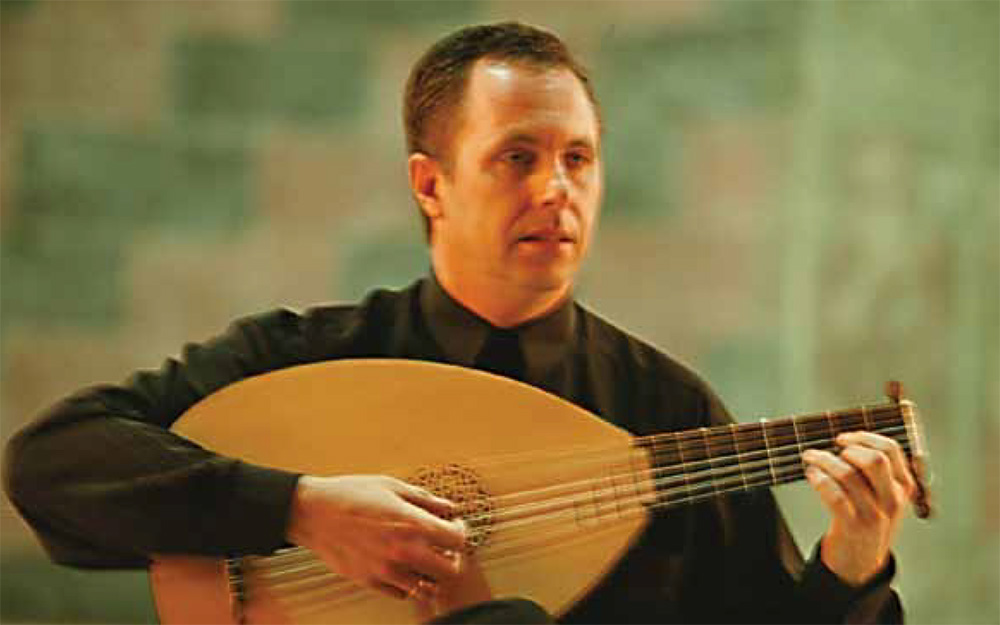
Mudarra's Harp Fantasia: History and Analysis
By John Griffiths
It is the Fantasia que contrahaze la harpa en la man era de Ludovico [Fantasia that imitates the harp in the style of Ludovico] that has secured the vihuelist Alonso Mudarra a place among those renaissance musicians whose music is frequently performed today.
Share this:
[feather_share]
First published in his Tres Libros de Musica en Cifras para Vmuela (Seville: Juan de Leon, 1546), both the novelty of sound and the ingenuity of conception have guaran- teed Mudarra’s fantasia a lasting attraction among vihuelists, lutenists and guitarists. Many guitar transcriptions have been published and, apart from individuality of fingering, most agree with the modifica- tions to the original tablature that appear in Emilio Pujol’s standard critical edition of Mudarra’s Tres libros ~. A facsimile of the original edition is also currently available The purpose of this article is to demonstrate the uniqueness of the Fantasia que contrahaze la harpa among fantasias for the vihuela: it is the earliest known set of variations on the FoliJl, written by Mudarra to emulate a renowned harpist of a previous generation. The work thus contains a second layer of information based on Mudarra’s perceptions of solo instrumental improvisation of an earlier age. My inten- tion here, however, is not principally to provide an historical discourse, but rather to expose a set of his- torical and analytical facts that might stimulate per- formers towards a style of interpretation based on a new vision of the work one which challenges various accepted notions.
The fame that this fantasia enjoys are due above all to its novel harplike sound effects. Of the 219 fantasias that survive for the vihuela, it is the only one that makes use of special idiomatic effects, imitating on one stringed instrument sounds belonging to another. Instead of relying on imitative counterpoint, the usual staple ingredient of the fantasia, here we find arpeggios, embellished and syncopated passages, as well as various kinds of chromaticism and dissonance. These are the ingredients from which the harp effect is created. Mudarra was also obviously aware of the novelty of his work. This must have been his reason for adding at the beginning of the work the comment that it es dificil hasta ser entendida [it is difficult until it is understood] and, from bar 125 of the original tablature, that Desde aqui fasta acerca del final ay Algunas falsas taniendose bien no parecen mal [from here almost to the end are several dissonances which, when played well, do not sound bad]. These effects are well known to all that have played or heard the work.
What has been overshadowed by the special harp effects of the work is its relationship to the melodic- harmonic scheme that a few decades later came to be known as the folia. As the following analysis reveals, the fantasia comprises three variations on the folia. Consistent with the general characteristics of vihuela fantasias, Mudarra’s work reveals a rational scheme of balanced formal architecture, the typical symmetry of all renaissance art. At the same time it possesses an extraordinarily dynamic forward motion that enables it to develop with fluidity and brilliance. It epitomizes the union of static architectural design and dynamic movement through time.
The discovery of this hitherto undisclosed formal contruction invites an historical explanation, and leads to questions concerning performance and interpretation. That in 1546 Mudarra published a solo instrurnental work based on the folia is in itself of significance @ It must not be mere coincidence that Mudarra chose to use the folia in a fantasia that was conceived as a tribute to a famous musician of the previous century .He must have had some notion of how players of an older generation improvised, and used this as the basis of his composition.
The identity of the Ludovico to whom the “Harp Fantasia” is dedicated cannot be established with absolute certainty, although all evidence points to a minstrel employed by Ferdinand the Catholic who reigned jointly with Isabel of Castille from 1469 to 1502. According to documents gathered by the nineteenth-century music historian Barbieri and cited by Pujol in his study on Mudarra, a musician named “Ludovico el del Arpa” was employed at that court. It appears that this harpist was of extraordinary skill and repute, and that he became something of a legendary figure. He is probably the same harpist that the theorist Juan Bermudo mentions in his Declaracion de de instrumentos musicales, (Ossuna, 1555). According to Bermudo, “Dizen que el nombrado Ludovico quando venia a clausular, poniendo el dedo debaxo de la cuerda, la semi- tonaua, y hazia clausula de sustientado”. [It is said that the renowned Ludovico, when he came to make a cadence, put his finger beneath the string to [raise it] a semitone, thus making a leading-tone cadence. It is precisely the imitation of these cadences that gives Mudarra’s fantasia it character and individuality. We may suppose, on this basis, that Mudarra wrote his fantasia as a homage to this already legendary harpist, using the devices for which Ludovico was famous as the basis of his sound effects. He must have chosen to cast the piece in variation form knowing it to have been the musical style that, to musicians of the last third of the fifteenth century , enjoyed a high status equivalent to the imitative fantasia of his own time. Mudarra thus transmits to us information of great historical significance. Not only does he imitate the sound of Ludovico’s sharpened cadences, but he also trans- mits a knowledge of the style and structure of pieces created by late sixteenth-century solo instrumentalists about whose improvisatory practices scarcely any other documentation remains.
Even though the earliest piece named folia dates from 1593, it is evident that the harmonic progression that it defines had already evolved by 1500, and that during the sixteenth century, it was widely used for variation writing under various names. (1) The evidence suggested by Mudarra’s fantasia is that a tradition of improvising on set harmonic schemes including the folia had already evolved during the fifteenth century .This is significantly earlier than the French and Italian dances found in early sixteenth-century printed lute books, and more so than the earliest diferencias [variations] published in Narvaez’s vihuela book of 1538.
ANALYSIS
The Fantasia que contrahaze la harpa is composed as three continuous folia variations, both in its melody and harmony. The first variation takes up 95 of the 157 bars of tablature that comprise the work.
The remaining 62 bars divide into two variations of almost equal length. The opening of the original tablature is shown in Example 1.
Example 1. Mudarra, Tres libros de musica, fols 13,13v.
None of the three variations presents the folia formula identically, nor does any conform to the folia formula that became stabilized in the seventeenth century .The folia formula in its evolved form is com pared with the three variants used by Mudarra in Example 2. Instead of the E minor chord that begins the evolved folia, Mudarra substitutes an A major chord, lowering the bass a fifth and the melodic note a third. This is not surprising as the first chord of the folia was the last to stabilize during its gradual historical development. The versions of Valderrabano and Pisador, for example, use the typical sixteenth-century procedure of commencing on the second chord of the progression, omitting the opening E minor altogether. In Mudarra’s work however, the use of the A major chord permits the variations to proceed continuously with no cadential interruption. The work is thus able to develop not only with fluidity, but also with an insistent forward thrust. The melodic alteration of the scheme also gives it a more regular linear curve, rising through its first half and falling in the second.
Example 2. Melodic-harmonic formulae
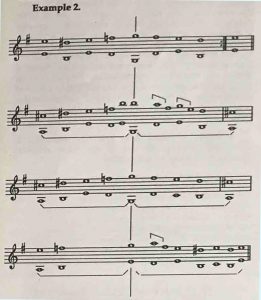 At the end of this article, I present a transcription of the Fantasia que contrahaze la harpa that shows the structure of the composition more clearly than those intended primarily for performance. By reducing the rhythmic values of the original tablature to one quarter their length, both formal structure and rhythmic subtlety are shown with maximum clarity. Thus, one crotchet of the transcription represents one bar of the original tablature. Barlines appear in the transcription only to mark important musical divisions; they do not denote metre. Double bars divide the variations. The bar numbering accords with the number of crotchets in the transcription, that is, with the bars of the original tablature.
At the end of this article, I present a transcription of the Fantasia que contrahaze la harpa that shows the structure of the composition more clearly than those intended primarily for performance. By reducing the rhythmic values of the original tablature to one quarter their length, both formal structure and rhythmic subtlety are shown with maximum clarity. Thus, one crotchet of the transcription represents one bar of the original tablature. Barlines appear in the transcription only to mark important musical divisions; they do not denote metre. Double bars divide the variations. The bar numbering accords with the number of crotchets in the transcription, that is, with the bars of the original tablature.
In the original tablature, errors occur in two places and both concern rhythmic notation. Firstly, the barline separating bars 58 and 59 was omitted together with the minima that should be above the first figure of bar 59. Secondly, in the penultimate bar, there is a semiminim [= crotchet] figure that should be a fusa [= quaver]. These errors are not substantial, and are transcribed correctly in all editions I have seen.
However, in all these editions, including Pujol’s critical edition, other corrections are made that have no justification. The common correction that converts bar 91 into two bars appears incorrect. The brusqueness of its original form appears intentional: it is the sign that Mudarra gives to announce the join of the first two variations, the return to the initial point of departure.
Furthermore, the additional bar destroys the perfect symmetry of the first variation with its two halves of 48 bars each. The alteration has been widely accepted because it maintains the consistency of the arpeggio figure established early in the piece, although in terms of the present analysis it eradicates a special signal that Mudarra is trying to convey, one that can be jus- tilled in terms of the fantasia’s internal symmetry. The other frequent and unnecessary correction is to the bass in bars 115 and 117. Once again, these bars have been altered by modern editors to provide textural consistency throughout the sequence that begins at this point. The syncopated bass in the original, however, represents the composer’s resolution of a technical problem. Mudarra appears to have chosen to syncopate the bass in order to avoid the awkwardness for the right hand that results on the vihuela if textural consistency is strictly maintained. The solution he chose does not destroy the balance of the passage, if anything it enhances the syncopation of the middle voice. The tablature with both literal and Pujol’s “corrected” transcriptions are shown in
Example 3. Transcription variants.
The first variation of 95 bars is composed sym- metrically, arriving at its climax exactly at its mid point at bar 48 on the G major chord, with the melodic b in the upper voice. Due apparently to the length of this variation, Mudarra extends the normal range of the melodic scheme by a third, from 9 to b. The melodic-harmonic scheme is also varied in both halves to control the impetus with which the work unfolds, distorting the harmonic-melodic symmetry yet maintaining them in equal periods of time. In the first half, Mudarra adds one chord (E minor) between the fourth and fifth chords of the formula (bars 44-47). He arrives at this point with the melody having risen by step from the initial C# up to g. To arrive at his first climax, the upper voice skips a third to arrive at b at bar 48, a foreshortening that gives strong impetus to the work’s forward momentum. For the descent in the second half of the variation, Mudarra maintains the harmonic progression of the folia scheme, but elaborates the melodic skeleton with the pair of descending thirds above the D major and E minor chords between bars 55 and 71. (Refer to Example 2.) In this way the impetus acquired in the first half of the variation is dissipated gradually but without losing the work’s rhythmic momentum.
Within the first variation, the melodic skeleton is elaborated by three figures. The first is the three-note figure that opens the work, the filled falling third that terminates on the main note of the melodic skeleton.
This cell emphasizes the folia melody. It also provides the germ for further melodic development within the work, introducing interplay between the notes of the melodic skeleton and those a third higher. Example 4 shows the use of this cell in the first variation. The other two figures are those which imitate the harp: the arpeggios whose notes are marked in the tablature with a cirromflex to show that they should be sustained, and the extended redobles [figurations] that parody Ludovico’s talent for chromatic alteration of cadences. The purpose of these redoble passages is to direct the music to each subsequent note of the folia formula, while the arpeggios reinforce the harmonic scheme and maintain rhythmic continuity .In the redobles, Mudarra places the note d# on the second string with e being the open first so that both sound concurrently in order to reproduce something of the sonority of the harp. Many guitar transcriptions carry the same idea even further through the use of more elaborate left-hand fingerings. In these redobles, groups of three notes are used within duple metre, adding a further dimension to the effect. Whether these are per- formed according to their melodic pattern or with ac- cents to maintain strict metre is a matter for individual choice, and neither interpretation can be preferred on historical grounds. The assymmetrical option deserves consideration as the resultant 3+3+2 pattern attains considerable structural significance in the later variations.
Example 4 shows how the first variation is elaborated through the use of the three elements described. Repetitions are omitted.
Example 4. Variation 1, schematic reduction
The first variation is exploratory in nature. It is little more than the folia sequence set out in somewhat irregularly over a ninety-five bar period. Each melodic note is reinforced by a short melodic cell and by harmonic arpeggiation, and short connecting phrases lace these together.
This is in keeping with the work’s origin as improvised music. Rather than the usual modem interpretation of this fantasia with dance-Iike rhythmic strictness, there is considerable scope to treat the opening with more freedom as if it were, in fact, being improvised. Each new chord can be treated as if it were a goal, and thus suitably stressed, but the journey between each “goal” can be treated more flexibly in order to create the improvisatory effect. Later in the fantasia, rhythmic insistence is more crucial.
The second variation possesses the same symmetry as the first. Its first part, bars 95 to 110, reiterates a new melodic phrase four times as an ascending sequence that follows the stepwise ascent of the folia melody. This figure elaborates on the interplay of thirds that occurs in the first variation. It begins at the lowest ebb of the work’s inner drama, following the forty-seven bar descent from the first climax point, but rises quickly to a second peak at bar 111. The second half of this variation, bars 111 to 124, sustains the force of the climax. It presents the folia melody and bass in skeletal form, modified only in the penultimate chord where the normal bass note of e is replaced by a c. The strength and dynamism of the passage is created by the rhythm of the inner voice whose semiquavers are grouped 3+3+2 against the strict duple metre of the other parts. As this climax is achieved more rapidly, it appears to have greater force than the preceding one. However, in view of this climax occurring in the middle of a variation, there seems to be no justification for the change in tempo made at this point by many per- formers. The need to slow down from bar 111 can be obviated by an interpretation of the first variation ac- cording to the criteria set out above. Slowing the tempo at this point obscures the listener’s perception of the work’s form: it does nothing to enhance the music.
The syncopated figure introduced in the second variation, reminiscent of the opening “harp cadence” (bars 9-13), is transferred into the upper voice for the third variation, and continues the work’s dynamism. In this variation, the folia scheme is treated with greater freedom. The ascending hall of the formula is reduced to two chords: A major from bars 125 to 134, and B minor in bars 135 -142. While the treble part reiterates the 3+3+2 rhythmic figure, using the inter- play of thirds for its melodic substance, the bass rises a fifth by step from a to e, and this is then repeated in syncopated and diminished form. The same process is repeated a tone higher on the B minor chord, although the syncopation of the shorter bass repetition is smoothed out. It is this passage that provoked Mudarra to add the cautionary remark about dissonances. The conflict between d# in the upper part and d natural in the bass, as well as the accented fourths, sevenths and ninths, does more than add dissonance, it creates a temporary sense of bitonality .This passage is the most dramatic representation of the legendary cadences for which Ludovico was famed, and creates a wonderful effect on the vihuela or guitar.
Preparation for the final cadence is achieved by the addition of two chords in the second half of the variation. As well as retarding the work’s accumulated impetus, these extra chords balance the simplification of the chordal pattern in the first half. This last section begins at bar 143 with further reiterations of the 3+3+2 syncopation accompanied by the regular harmonies of the folia, which are converted into redobles from bar 149, in preparation for the final cadence.
Even though words are frequently an inadequate means of describing musical phenomena, Mudarra’s Fantasia que contrahaze la harpa can readily be described and understood due to the great clarity of its construction. It is a famous and extraordinary work that, inde- pendent of its artistry, reveals various important aspects of the early history of instrumental music. As the oldest conserved folia, it combines variation form with the typical structural balance of the fantasia genre, as well as informing us of the nature of solo instrumental improvisation some half century earlier than its own publication date. In addition, it is a marvellous work to play, and one which provides the listener with ample reward.
Footnotes:
(1) This study is based on my article “La ‘Fantasia que contrahaze la harpa’ de Alonso Mudarra; estudio historico-analitico” published in Revista de Musicologia, X (1986),29-40, but substantially modified here.
(2) Alonso Mudarra, Tres libros de musica en cifras para vihuela, ed. Emilio Pujol, Monumentos de la Musica Espanola, Vll, (Barcelona: Instituto Espanol de Musicologia, 1949, rpt. 1984).
(3) Monaco: Editions Chanterelle, 1980.
(4)Mudarra also used the opening progression of the folia as the harmonic basis for the second part of his Fantasia del quarto tono fi7r guitar (No.12), albeit in a more abstract form. See John Griffiths ‘The Vihuela Fantasia: a Comparative Study of Forms and Styles” (Diss., Monash, 1983), pp. 200-204.
(5)Mudarra, Tres libros de musica, op. dt. pp. 64- 66. Pujol does not give the exact source of his reference, and I have not been able to locate it among the archive of Barbieri documents in the Biblioteca Nadonal in Madrid.
(6) Fol.110.
(7)The earliest use of the term occurs in the Ramil- lete de flares manuscript, Madrid Bibl. Nac. MS 6001. Concerning other early folias, several songs from the fifteenth-century Cancionera del Palacia are derived from it, as are several instrumental pieces of the sixteenth century published in the vihuela books of Valderrabano (1547) and Pisador (1552) under the name of Pavana.
(8) Luis de Narvaez, Los seys libros del Delphin, (Val- ladolid, 1538).
(9) The transcription and analytical commentary use E-tuning to make it conform with modem guitar pitch tuning. G-tuning renders the most satisfactory transcription in terms of renaissance tonality.
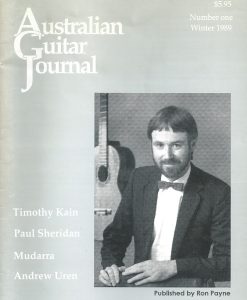

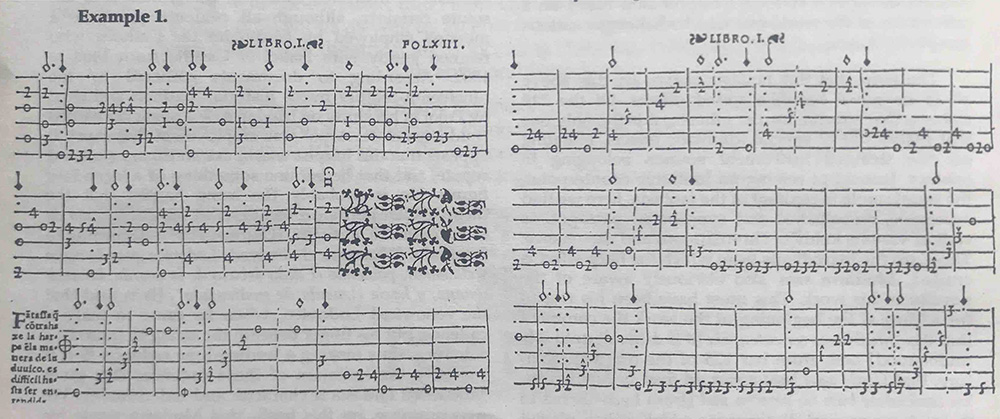
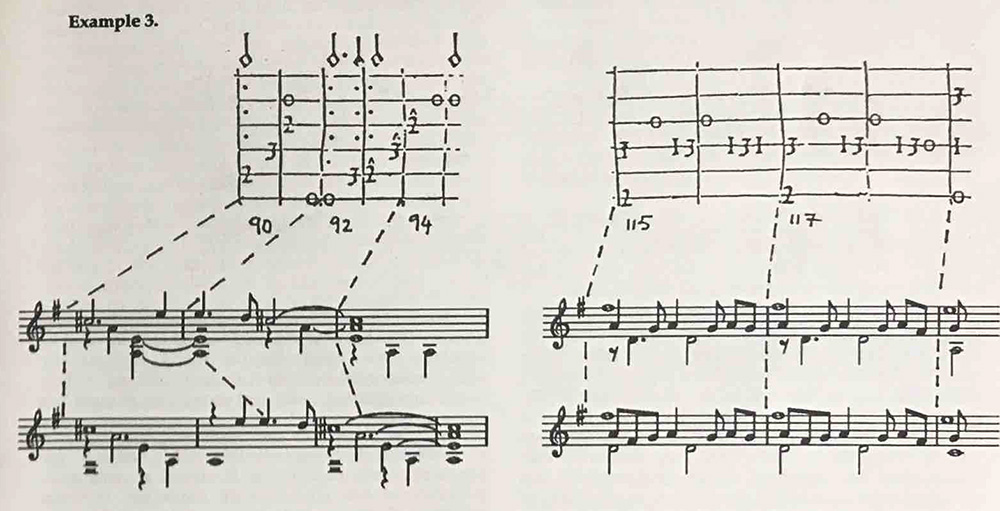
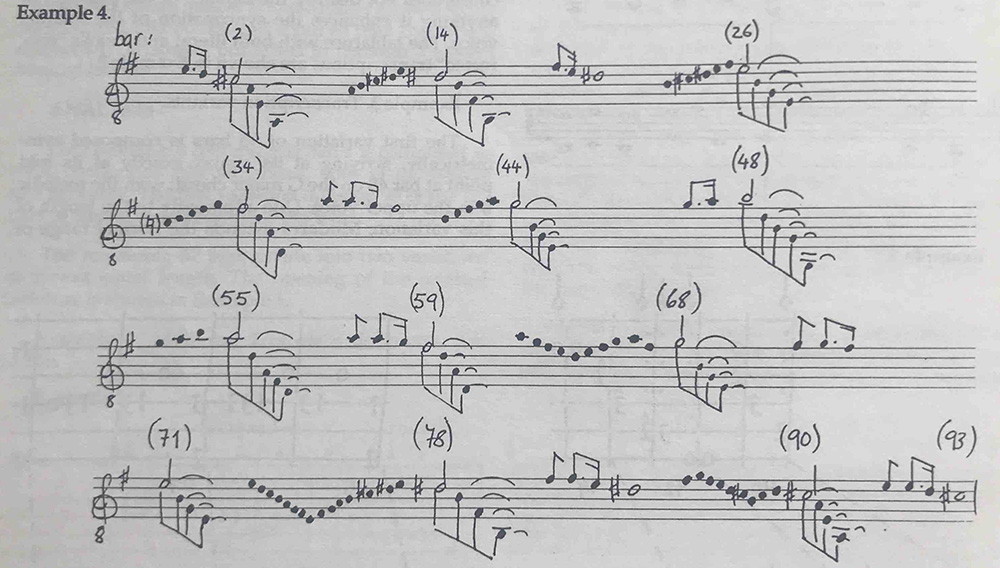
Dear Ron,
I hope you are doing well in this insane time.
I just discovered this John Griffiths Muddarra article and think it is brilliant! Unfortunately I can’t seem to find his transcription he says he did for modern guitar that I pasted at the bottom. I am a bit of a technophobe so it does not surprise me. If there were a way you could send it to me I would so so appreciate it! Thanks so much and thanks for posting this wonderfully enlightening article!!!
Be well!
Peace, love and Mudarra!!!
ben verdery
At the end of this article, I present a transcription of the Fantasia que contrahaze la harpa that shows the structure of the composition more clearly than those intended primarily for performance.